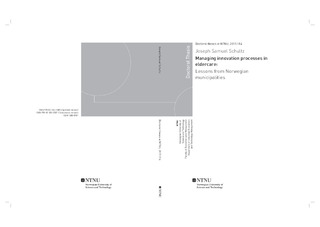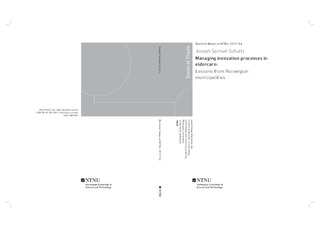| dc.contributor.advisor | Sjøvold, Endre | |
| dc.contributor.author | Schultz, Joseph Samuel | |
| dc.date.accessioned | 2017-06-22T07:57:01Z | |
| dc.date.available | 2017-06-22T07:57:01Z | |
| dc.date.issued | 2017 | |
| dc.identifier.isbn | 978-82-326-2301-3 | |
| dc.identifier.issn | 1503-8181 | |
| dc.identifier.uri | http://hdl.handle.net/11250/2446643 | |
| dc.description.abstract | Summary of the thesis
Eldercare policies are being dramatically reshaped due to demographic shifts worldwide. The elderly are living longer and healthier, and their infrastructural impacts on society are well known amongst researchers in eldercare (Kulik, Ryan, Harper, & George, 2014; Schultz, André, & Sjøvold, 2015, 2016). It is known that most developed countries will be experiencing unprecedented growths in their elder population (Aging, 2014; Kulik et al., 2014; Nations, 2013), but what is less known is how public-entities are going to provide these services in the future. These challenges are going to be especially difficult for those organizations or municipalities that are struggling to develop an innovative culture. For organizations that want to improve their innovativeness, some managers wonder can innovation be taught or is it something you are born with? These are issues this thesis will address. First, the thesis will address what and how Norwegian municipalities are innovating in the context of eldercare. Second, suggestions will be offered about how these innovation processes can be improved upon.
The results from the study show that Norwegian municipalities’ innovation strategy is focused primarily on facilitating the elderly in living in their own homes as long as possible with the use of smart in-home technology (see articles 1-2). While very few municipalities are emphasizing improving the work environment (e.g. recruitment) or prioritizing the utilization of innovation processes (see article 2).
Additionally, the results showed that innovation can be taught. More specifically, team composition (or group climate) and innovative readiness are closely linked (see article 3 and 4). The results showed that innovation can be contagious, just like positivity. If you comprise a group that has a strong enough interest in innovation, give them the resources they need to innovate, their enthusiasm will likely be contagious to the rest of the organization (see article 4). Furthermore, this thesis elaborates on how managers can build a new innovation process in their organization (see article 4). This is important for managers that are struggling to get their group or organization to think new or differently. The implications and limitations of these findings are discussed in more detail in each of the articles. | nb_NO |
| dc.description.abstract | Sammendrag av avhandlingen
Eldreomsorgspolitikken blir dramatisk omformet på grunn av demografiske endringer verden over. De eldre lever lengre og sunnere, og deres infrastrukturelle innvirkning på samfunnet er velkjent blant forskere innen eldreomsorg (Kulik, Ryan, Harper & George, 2014; Schultz, André, & Sjøvold, 2015, 2016). Det er kjent at de fleste utviklede land vil oppleve enestående vekst i sin eldre befolkning (Aging, 2014; Kulik et al., 2014; Nations, 2013), men det er langt mindre kjent hvordan offentlige organisasjoner, som er ansvarlige for å yte disse tjenestene, skal møte de kommende utfordringene. Spesielt gjelder dette de organisasjonene eller kommunene som sliter med å utvikle en nyskapende kultur, eller en vilje til å prøve noe nytt. Kan innovasjon læres eller er det en medfødt ferdighet? Dette er målet med denne avhandlingen - å ta opp hva og hvordan norske kommuner innoverer innen eldreomsorg. Det vil også bli fremlagt forslag om hvordan disse innovasjonsprosessene kan forbedres.
Resultatene fra studien viser at norske kommuners innovasjonsstrategi hovedsakelig er rettet mot å tilrettelegge slik at de eldre kan bo i eget hjem så lenge som mulig ved bruk av smarthjem teknologi (se artiklene 1-2). Svært få kommuner legger vekt på å forbedre arbeidsmiljøet (f.eks. rekruttering) eller prioritere utnyttelse av innovasjonsprosesser (se artikkel 2).
Resultatene fra studien viser også at innovasjon kan bli lært. I tillegg fant denne studien at gruppesammensetning (eller gruppeklima) og innovasjonsberedskap er nært knyttet sammen (se artikkel 3 og 4). Resultatene viste at innovasjon kan være smittsomt, akkurat som positive (eller negative) holdninger. Hvis man har en gruppe bestående av mennesker med sterk nok interesse for innovasjon, og man gir dem de ressursene de trenger for å innovere, så vil deres entusiasme trolig være smittsom overfor resten av organisasjonen (se artikkel 4). Videre utdyper denne oppgaven hvordan ledere kan bygge en ny innovasjonsprosess i sine organisasjoner (se artikkel 4). Dette er viktig for ledere som sliter med å få sin gruppe eller organisasjon til å tenke nytt eller annerledes. Implikasjonene og begrensningene av disse funnene blir nærmere omtalt i hver av artiklene. | nb_NO |
| dc.language.iso | eng | nb_NO |
| dc.publisher | NTNU | nb_NO |
| dc.relation.ispartofseries | Doctoral theses at NTNU;2017:114 | |
| dc.relation.haspart | Paper 1:
Schultz, Joseph Samuel; Andre, Beate; Sjøvold, Endre.
Demystifying eldercare: Managing and innovating from a public-entity’s perspective. International Journal of Healthcare Management 2015 ;Volum 8.(1) s. 42-57 - Is not included dut to copyright available at
http://dx.doi.org/10.1179/2047971914Y.0000000097 | |
| dc.relation.haspart | Paper 2:
Schultz, Joseph Samuel; Andre, Beate; Sjøvold, Endre.
Managing innovation in eldercare: A glimpse into what and how public organizations are planning to deliver healthcare services for their future elderly. International Journal of Healthcare Management 2016 ;Volum 9.(3) s. 169-180 -
Is not included dut to copyright available at
http://dx.doi.org/10.1080/20479700.2016.1142048 | |
| dc.relation.haspart | Paper 3:
Schultz, Joseph Samuel; Sjøvold, Endre; Andre, Beate.
Can group climate explain innovative readiness for change?. Journal of Organizational Change Management 2017 ;Volum 30.(3) s. 440-452 - Is not included dut to copyright available at
https://doi.org/10.1108/JOCM-06-2016-0112 | |
| dc.relation.haspart | Paper 4:
Schultz, Joseph Samuel; Sjøvold, Endre; Andre, Beate.
Can formal innovation training improve team- and organizational-level innovativeness in a healthcare setting?. Journal of Innovation and Entrepreneurship 2017
Creative Commons Attribution License 4.0. | |
| dc.subject | eldercare, innovation, innovation processes, organizational development, strategy | nb_NO |
| dc.subject | eldreomsorg, innovasjon, innovasjonsprosesser, organisasjonsutvikling, strategi | nb_NO |
| dc.title | Managing innovation processes in eldercare: Lessons from Norwegian municipalities | nb_NO |
| dc.type | Doctoral thesis | nb_NO |
| dc.subject.nsi | VDP::Social science: 200::Economics: 210 | nb_NO |

